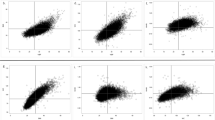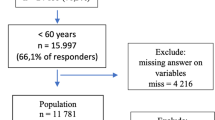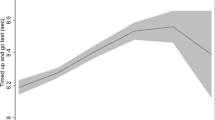Abstract
Objective:
To measure the risk of periretirement age disability associated with five different anthropometric measures of body mass and shape, and to compare the measures in this group, the peak age group of obesity prevalence.
Design:
Longitudinal study of Health Survey for England 1998 respondents followed-up in the English Longitudinal Study of Ageing in 2002.
Subjects:
National population sample of 1030 women and 888 men aged 55–74 years.
Measurements:
Five baseline exposure measures (weight (WT), body mass index (BMI), waist circumference (WC), hip circumference (HC), and waist-hip ratio (WHR)) at baseline, and disability outcomes (measured gait speed, self-reported mobility problems, instrumental and ordinary activities of daily living (I/ADLs)) after 5 years.
Results:
Individually, the heaviest quartile of WC and WHR predicted disability using all outcomes in men. In women, the heaviest category of each of the five exposure measures predicted disability, for each of the outcomes. In competing measures models, WC was included in the best fit model of tested mobility disability in men (odds ratio (OR) 2.4; 95% confidence interval (CI) 1.4–4.1; P<0.05) and women (OR 3.0; 95% CI 1.9–4.8; P<0.001), adjusted for age, height, smoking, social class, and education. WC was also included in the best fit model of all self-reported disabilities in men, and for self-reported I/ADL disabilities in women.
Conclusions:
Across the periretirement age period, body mass and shape are major determinants of disability, with increases in WC, a marker for abdominal obesity, best predicting risk for most disability outcomes. This result adds to the case for WC to be used in estimates of obesity-related health risks for epidemiological monitoring and clinical care.
This is a preview of subscription content, access via your institution
Access options
Subscribe to this journal
Receive 12 print issues and online access
$259.00 per year
only $21.58 per issue
Buy this article
- Purchase on Springer Link
- Instant access to full article PDF
Prices may be subject to local taxes which are calculated during checkout

Similar content being viewed by others
References
Jain A . Fighting obesity. BMJ 2004; 328: 1327–1328.
Flegal KM, Carroll MD, Ogden CL, Johnson CL . Prevalence and trends in obesity among US adults, 1999–2000. JAMA 2002; 288: 1723–1727.
Kuczmarski RJ, Flegal KM, Campbell SM, Johnson CL . Increasing prevalence of overweight among US adults. The National Health and Nutrition Examination Surveys, 1960 to 1991. JAMA 1994; 272: 205–211.
Health, United States. Table 70. Healthy weight, overweight, and obesity among persons 20 years of age and over, according to sex, age, race, and Hispanic origin: United States, 1960–62, 1971–74, 1976–80, 1988–94, and 1999–2000. CDC, National Center for Health Statistics, National Health and Nutrition Examination Survey, Hispanic Health and Nutrition Examination Survey, and National Health Examination Survey. http://www.cdc.gov/nchs/data/hus/tables/2002/02hus070.pdf.2002. 22–12–2003.
Health Survey for England 2003. Sproston, K, Primatesta P . 17–12–2004. Norwich, The Stationery Office for the National Centre for Social Research, University College Medical School, and the Department of Health.
Rashid MN, Fuentes F, Touchon RC, Wehner PS . Obesity and the risk for cardiovascular disease. Prev Cardiol 2003; 6: 42–47.
Galanis DJ, Harris T, Sharp DS, Petrovitch H . Relative weight, weight change, and risk of coronary heart disease in the Honolulu Heart Program. Am J Epidemiol 1998; 147: 379–386.
Harris TB, Launer LJ, Madans J, Feldman JJ . Cohort study of effect of being overweight and change in weight on risk of coronary heart disease in old age. BMJ 1997; 314: 1791–1794.
Harris MI, Hadden WC, Knowler WC, Bennett PH . Prevalence of diabetes and impaired glucose tolerance and plasma glucose levels in US population aged 20–74 yr. Diabetes 1987; 36: 523–534.
Wilson PW, Anderson KM, Kannel WB . Epidemiology of diabetes mellitus in the elderly. The Framingham Study. Am J Med 1986; 80: 3–9.
Ford ES, Williamson DF, Liu S . Weight change and diabetes incidence: findings from a national cohort of US adults. Am J Epidemiol 1997; 146: 214–222.
Wannamethee SG, Shaper AG . Weight change and duration of overweight and obesity in the incidence of type 2 diabetes. Diab Care 1999; 22: 1266–1272.
Ettinger WH, Davis MA, Neuhaus JM, Mallon KP . Long-term physical functioning in persons with knee osteoarthritis from NHANES. I: Effects of comorbid medical conditions. J Clin Epidemiol 1994; 47: 809–815.
Anderson JJ, Felson DT . Factors associated with osteoarthritis of the knee in the first national Health and Nutrition Examination Survey (HANES I). Evidence for an association with overweight, race, and physical demands of work. Am J Epidemiol 1988; 128: 179–189.
Bender R, Jockel KH, Trautner C, Spraul M, Berger M . Effect of age on excess mortality in obesity. JAMA 1999; 281: 1498–1504.
Calle EE, Thun MJ, Petrelli JM, Rodriguez C, Heath Jr CW . Body-mass index and mortality in a prospective cohort of US adults. N Engl J Med 1999; 341: 1097–1105.
Calle EE, Rodriguez C, Walker-Thurmond K, Thun MJ . Overweight, obesity, and mortality from cancer in a prospectively studied cohort of US adults. N Engl J Med 2003; 348: 1625–1638.
Banegas JR, Lopez-Garcia E, Gutierrez-Fisac JL, Guallar-Castillon P, Rodriguez-Artalejo F . A simple estimate of mortality attributable to excess weight in the European Union. Eur J Clin Nutr 2003; 57: 201–208.
Seguin R, Nelson ME . The benefits of strength training for older adults. Am J Prev Med 2003; 25: 141–149.
World Health Organization. International Classification of Functioning, Disability, and Health (ICF) 2001. WHO: Geneva.
Harris T, Kovar MG, Suzman R, Kleinman JC, Feldman JJ . Longitudinal study of physical ability in the oldest-old. Am J Public Health 1989; 79: 698–702.
Penninx BW, Ferrucci L, Leveille SG, Rantanen T, Pahor M, Guralnik JM et al. Lower extremity performance in nondisabled older persons as a predictor of subsequent hospitalization. J Gerontol A Biol Sci Med Sci 2000; 55: M691–M697.
Guralnik JM, Simonsick EM, Ferrucci L, Glynn RJ, Berkman LF, Blazer DG et al. A short physical performance battery assessing lower extremity function: association with self-reported disability and prediction of mortality and nursing home admission. J Gerontol 1994; 49: M85–M94.
Fried LP, Guralnik JM . Disability in older adults: evidence regarding significance, etiology, and risk. J Am Geriatr Soc 1997; 45: 92–100.
Inouye SK, Wagner DR, Acampora D, Howitz RI, Cooney Jr LM, Tinetii ME et al. A controlled trial of a nursing-centered intervention in hospitalized elderly medical patients: the Yale Geriatric Care Program. J Am Geriatr Soc 1993; 41: 1353–1360.
Guralnik JM, Ferrucci L, Pieper CF, Leveille SG, Markides KS, Ostir GV et al. Lower extremity function and subsequent disability: consistency across studies, predictive models, and value of gait speed alone compared with the short physical performance battery. J Gerontol A Biol Sci Med Sci 55; 2000: M221–M231.
Coakley EH, Kawachi I, Manson JE, Speizer FE, Willet WC, Colditz GA . Lower levels of physical functioning are associated with higher body weight among middle-aged and older women. Int J Obes Relat Metab Disord 1998; 22: 958–965.
Pinsky JL, Branch LG, Jette AM, Haynes SG, Feinleib M, Cornoni-Huntley JC et al. Framingham Disability Study: relationship of disability to cardiovascular risk factors among persons free of diagnosed cardiovascular disease. Am J Epidemiol 1985; 122: 644–656.
Allison DB, Faith MS, Heo M, Kotler DP . Hypothesis concerning the U-shaped relation between body mass index and mortality. Am J Epidemiol 1997; 146: 339–349.
Folsom AR, Kaye SA, Sellers TA, Hong CP, Cerhan JR, Potter JD et al. Body fat distribution and 5-year risk of death in older women. JAMA 1993; 269: 483–487.
Keys A, Taylor HL, Blackburn H, Brozek J, Anderson JT, Simonson E . Mortality and coronary heart disease among men studied for 23 years. Arch Intern Med 1971; 128: 201–214.
Baumgartner RN, Heymsfield SB, Roche AF . Human body composition and the epidemiology of chronic disease. Obes Res 1995; 3: 73–95.
Marmot M, Banks J, Blundell R, Lessof C, Nazroo J . Health wealth and lifestyles of the older population in England: The 2002 English Longitudinal Study of Ageing. London The Institute for Fiscal Studies, 2003.
Health Survey for England Cardiovascular Disease '98. Erens B, Primatesta P . 14–12–1999. UK, Great Britain Department of Health, National Centre for Social Research (SCPR), Joint Health Surveys Unit Royal Free and University College Medical School. London, Department of Epidemiology and Public Health, 1999.
Clinical guidelines on the identification, evaluation, and treatment of overweight and obesity in adults – the evidence report. National institutes of health. Obes Res 1998; 6 (Suppl 2): 51S–209S.
Guralnik JM, Ferrucci L, Simonsick EM, Salive ME, Wallace RB . Lower-extremity function in persons over the age of 70 years as a predictor of subsequent disability. N Engl J Med 1995; 332: 556–561.
Wallace RB, Herzog AR . Overview of the health measures in the Health and Retirement Study. J Human Resources 2005; 30: S84–S107.
Janssen I, Katzmarzyk PT, Ross R . Waist circumference and not body mass index explains obesity-related health risk. Am J Clin Nutr 2004; 79: 379–384.
Bigaard J, Tjonneland A, Thomsen BL, Overvad K, Heitmann BL, Sorensen TI . Waist circumference, BMI, smoking, and mortality in middle-aged men and women. Obes Res 2003; 11: 895–903.
Garn SM, Leonard WR, Hawthorne VM . Three limitations of the body mass index. Am J Clin Nutr 1986; 44: 996–997.
Bagust A, Walley T . An alternative to body mass index for standardizing body weight for stature. QJM 2000; 93: 589–596.
Deurenberg P, Yap M, van Staveren WA . Body mass index and percent body fat: a meta analysis among different ethnic groups. Int J Obes Relat Metab Disord 1998; 22: 1164–1171.
Eckhardt CL, Adair LS, Caballero B, Avila J, Kon IY, Wang J et al. Estimating body fat from anthropometry and isotopic dilution: a four-country comparison. Obes Res 2003; 11: 1553–1562.
Heiat A . Impact of age on definition of standards for ideal weight. Prev Cardiol 2003; 6: 104–107.
Bigaard J, Frederiksen K, Tjonneland A, Thomsen BL, Overvad K, Heitmann BL et al. Waist and hip circumferences and all-cause mortality: usefulness of the waist-to-hip ratio? Int J Obes Relat Metab Disord 2004; 28: 741–747.
Stewart KJ, DeRegis JR, Turner KL, Bacher AC, Sung J, Hees PS et al. Usefulness of anthropometrics and dual-energy X-ray absorptiometry for estimating abdominal obesity measured by magnetic resonance imaging in older men and women. J Cardiopulm Rehabil 2003; 23: 109–114.
Zamboni M, Turcato E, Armellini F, Kahn HS, Zivelonghi A, Santana H et al. Sagittal abdominal diameter as a practical predictor of visceral fat. Int J Obes Relat Metab Disord 1998; 22: 655–660.
Pouliot MC, Despres JP, Lemieux S, Moorjani S, Bouchard C, Tremblay A et al. Waist circumference and abdominal sagittal diameter: best simple anthropometric indexes of abdominal visceral adipose tissue accumulation and related cardiovascular risk in men and women. Am J Cardiol 1994; 73: 460–468.
Klein S . The case of visceral fat: argument for the defense. J Clin Invest 2004; 113: 1530–1532.
Nielsen S, Guo Z, Johnson CM, Hensrud DD, Jensen MD . Splanchnic lipolysis in human obesity. J Clin Invest 2004; 113: 1582–1588.
Brochu M, Poehlman ET, Ades PA . Obesity, body fat distribution, and coronary artery disease. J Cardiopulm Rehabil 2000; 20: 96–108.
Larsson B . Obesity, fat distribution and cardiovascular disease. Int J Obes 1991; 15 (Suppl 2): 53–57.
Pouliot MC, Despres JP, Nadeau A, Moorjani S, Prud'Homme D, Lupien PJ et al. Visceral obesity in men. Associations with glucose tolerance, plasma insulin, and lipoprotein levels. Diabetes 1992; 41: 826–834.
Sironi AM, Gastaldelli A, Mari A, Ciociaro D, Postano V, Buzzigoli E et al. Visceral fat in hypertension: influence on insulin resistance and beta-cell function. Hypertension 2004; 44: 127–133.
Folsom AR, Kushi LH, Anderson KE, Mink PJ, Olson JE, Hong CP et al. Associations of general and abdominal obesity with multiple health outcomes in older women: the Iowa Women's Health Study. Arch Intern Med 2000; 160: 2117–2128.
Flegal KM, Graubard BI, Williamson DF, Gail MH . Excess deaths associated with underweight, overweight, and obesity. JAMA 2005; 293: 1861–1867.
Chatterjee S, Hadi A, Price B . Regression analysis by example. John Wiley & Sons: New York, 2000.
Acknowledgements
SA is funded by the National Institutes of Health-University of Cambridge Health Science Scholar Graduate Partnership Program. DM holds analysis grants from the National Institute on Aging (5 R03 AG022912–02) and the UK Health Foundation. We thank the English Longitudinal Study of Ageing and the Health Survey for England for access to datasets. Thanks to Fiona Matthews, Brenda McWilliams and Elizabeth Gardener for their help in data analysis. This work was completed primarily at the University of Cambridge.
Author information
Authors and Affiliations
Corresponding author
Rights and permissions
About this article
Cite this article
Angleman, S., Harris, T. & Melzer, D. The role of waist circumference in predicting disability in periretirement age adults. Int J Obes 30, 364–373 (2006). https://doi.org/10.1038/sj.ijo.0803130
Received:
Revised:
Accepted:
Published:
Issue Date:
DOI: https://doi.org/10.1038/sj.ijo.0803130
Keywords
This article is cited by
-
Higher abdominal adiposity is associated with higher lean muscle mass but lower muscle quality in middle-aged and older men and women: the Framingham Heart Study
Aging Clinical and Experimental Research (2023)
-
Visceral fat area is the measure of obesity best associated with mobility disability in community dwelling oldest-old Chinese adults
BMC Geriatrics (2021)
-
Is the 10 metre walk test on sloped surfaces associated with age and physical activity in healthy adults?
European Review of Aging and Physical Activity (2019)
-
Association of adiposity, telomere length and mortality: data from the NHANES 1999–2002
International Journal of Obesity (2018)
-
Abdominal Obesity and Mobility Disability in Older Adults: A 4-Year Follow-Up of the International Mobility in Aging Study
The Journal of nutrition, health and aging (2018)



